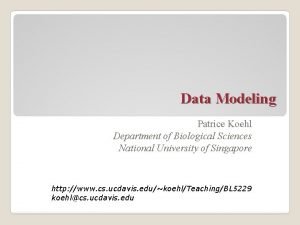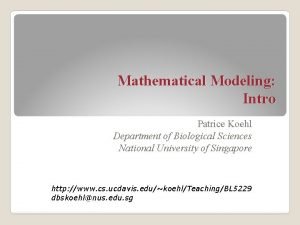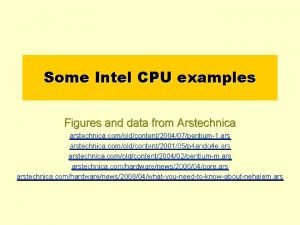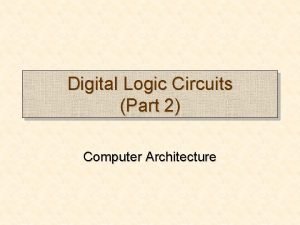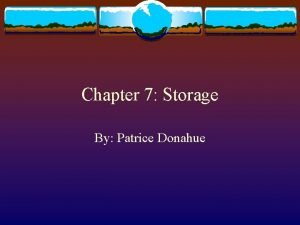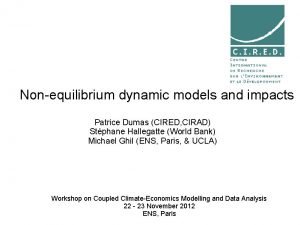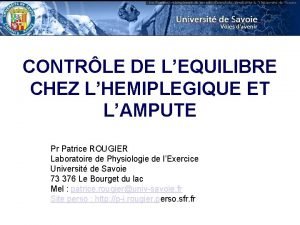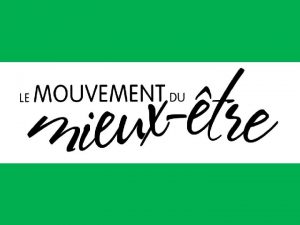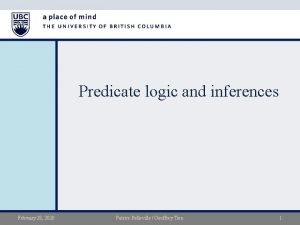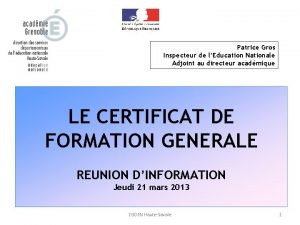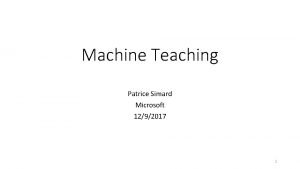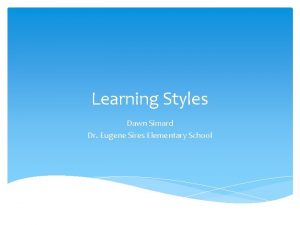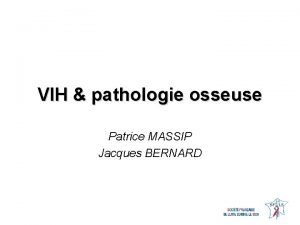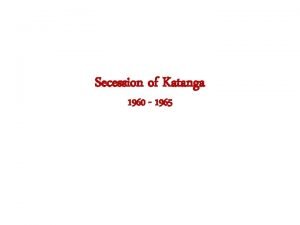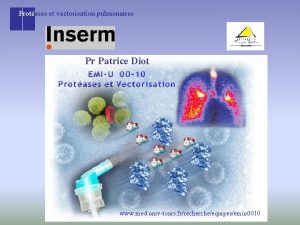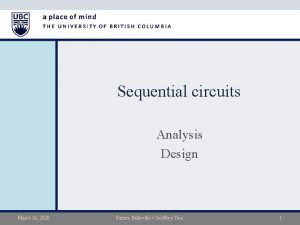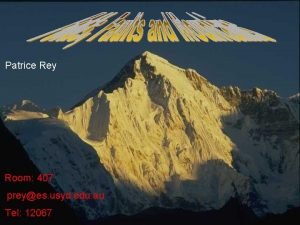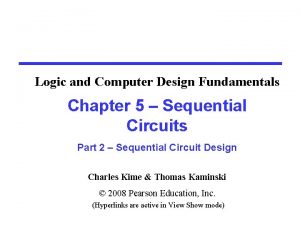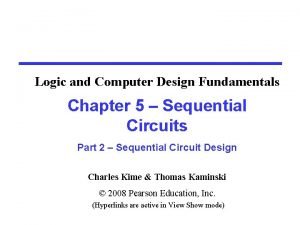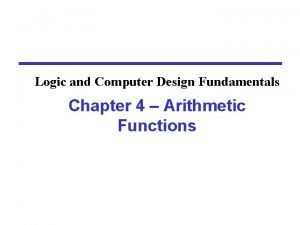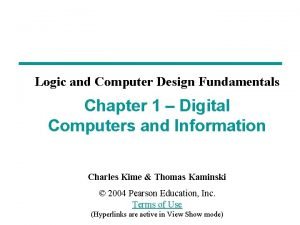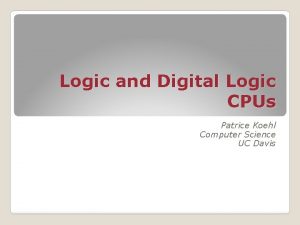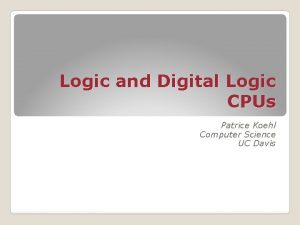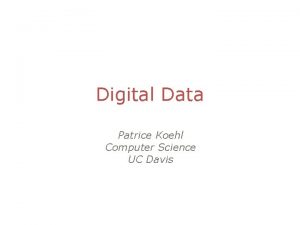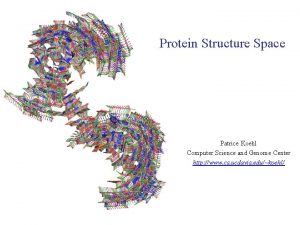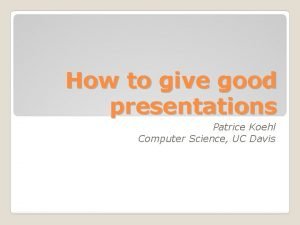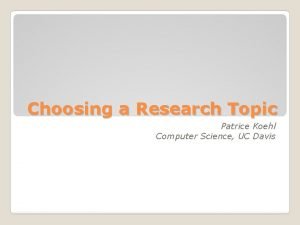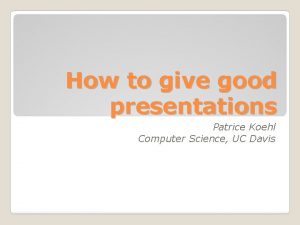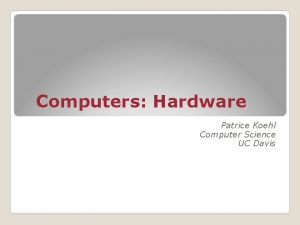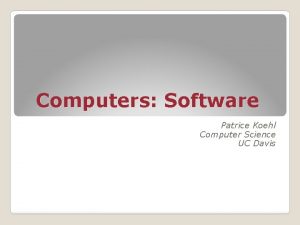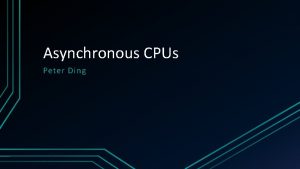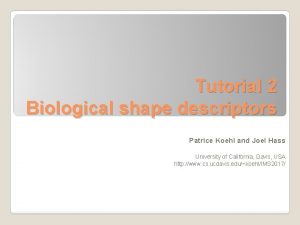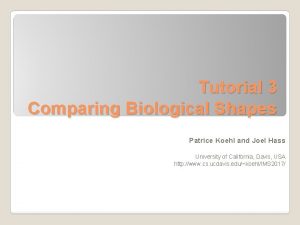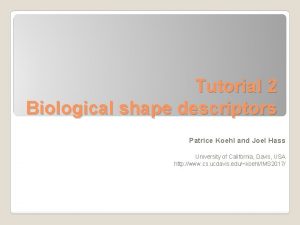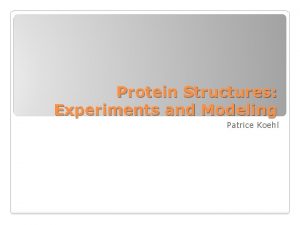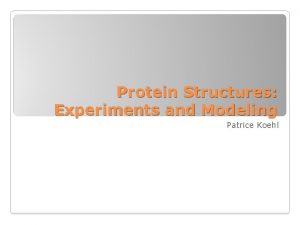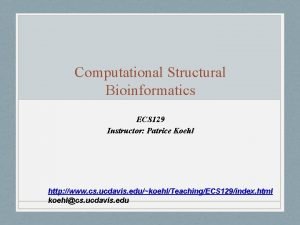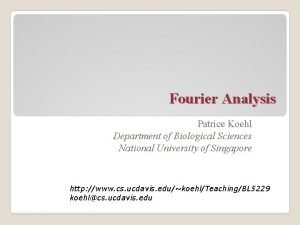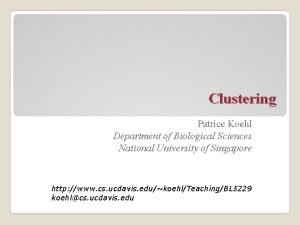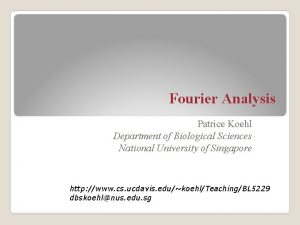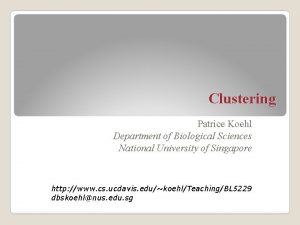Logic and Digital Logic CPUs Patrice Koehl Computer


























![Step 4: Instruction Execution PC: 2200 [800] Execute: Add numbers 42 and 12 in Step 4: Instruction Execution PC: 2200 [800] Execute: Add numbers 42 and 12 in](https://slidetodoc.com/presentation_image_h/1e3124cddf2b4c780a6c9995ea0510cf/image-27.jpg)






- Slides: 33

Logic and Digital Logic CPUs Patrice Koehl Computer Science UC Davis

Basic Concepts (part II) Logic ◦ Proposition ◦ Operation on propositions Digital Logic - The transistor - Gates CPU ◦ Order of operations ◦ Speed

Basic Concepts (part II) Logic ◦ Proposition ◦ Operation on propositions Digital Logic - The transistor - Gates CPU ◦ Order of operations ◦ Speed

Logic: proposition Definition: A proposition is a declarative sentence that is either true (T, or 1) or false (F, or 0). We refer to 1 or 0 as the truth value of the proposition. Examples: Sentence Proposition? Truth value 1+1=4 Yes 0 Today is Friday Yes 1 It will rain tomorrow Yes We will know tomorrow… X+1=2 No I am lying now No

Logic: compound propositions Negation: Let p be a proposition. The sentence “it is not the case that p” is another proposition, called the negation of p, denoted ¬p or ~p. It is also read as “not p”. Truth table p ¬p 1 0 0 1 “inverter”

Logic: compound propositions Conjunction: The conjunction of two propositions p and q is the proposition p q (read “p and q”) that is true if and only if both p and q are true. Truth table: p 0 0 1 1 q 0 1 p q 0 0 0 1 “Multiplication”

Logic: compound propositions Disjunction: The disjunction of two propositions p and q is the proposition p q (read “p or q”) that is true if and only if p or q, or both are true. Truth table: p 0 0 1 1 q 0 1 p q 0 1 1 1 “Addition”

Basic Concepts (part II) Logic ◦ Proposition ◦ Operation on propositions Digital Logic - The transistor - Gates CPU ◦ Order of operations ◦ Speed

The concept of pressure When we remove the block, what is the effect on pressure?

The concept of pressure Stays the same Decreases

Electrical pressure: voltage Vcc If switch is off (0) (equivalent to the presence of the block) Voutput=Vcc high (i. e. 1) Resistor Output Switch If switch is on (1) (equivalent to the absence of the block) Voutput<<Vcc low (i. e. 0) Ground “Inverter”

The transistor Collector A transistor can be used as an electronic switch: -if Vbase is high, the current “flows” between the emitter and the collector (switch is on) Base Emitter -If Vbase is low, the current does not pass (switch is off)

The not gate 1 Input: 0 0 Input: 1 Input Output 0 1 1 0

The not-and (NAND) gate Input A Input B Output 1 1 0 1 0 1 1 0 0 1

The AND gate Input A Input B Output 1 1 0 0 0 1 0 0

The not-or (NOR) gate Input A Input B Output 1 1 0 0 0 1

The OR gate Input A Input B Output 1 1 0 0 0

http: //en. wikipedia. org/wiki/Logic_gate

Integrated Circuit - A computer central processing unit (CPU) is an electronic circuit combining millions of these logical digital gates and other electronic components. -While the transistor was key to the development of computers, another major step was the possibility to miniaturized to the extreme the design of these electronic circuits: this was made possible by the invention of the Integrated Circuit (or IC, microcircuits, microchips, silicon chips or chips). There has been several generations of IC: -SSI: small scale integration -MSI: medium scale integration -LSI: large scale integration -VLSI: very large scale integration -Moore’s law (1965): “The complexity for minimum component costs has increased at a rate of roughly a factor of two per year. Certainly over the short term this rate can be expected to continue”


Basic Concepts (part II) Logic ◦ Proposition ◦ Operation on propositions Digital Logic - The transistor - Gates CPU ◦ Order of operations ◦ Speed

The Central Process Unit (CPU) CPU ALU Control Memory The CPU consists of three parts: -the Arithmetic Logic Unit (ALU) -The Control Unit -Memory Input Output

The Fetch/Execute Cycle The CPU cycles through a series of operations or instructions, organized in a cycle, the Fetch/Execute cycle: 1. Instruction Fetch (IF) 2. Instruction Decode (DP) 3. Data Fetch (DF) 4. Instruction Execute (IE) 5. Result Return

Step 1: Instruction Fetch instruction from memory position 2200: Add numbers in memory positions 884 and 428, and store results at position 800

Step 2: Instruction Decode instruction: Defines operation (+), and set memory pointers in ALU

Step 3: Data Fetch PC: 2200 Fetch data: Get numbers at memory positions 428 and 884: 42 and 12 and put in ALU
![Step 4 Instruction Execution PC 2200 800 Execute Add numbers 42 and 12 in Step 4: Instruction Execution PC: 2200 [800] Execute: Add numbers 42 and 12 in](https://slidetodoc.com/presentation_image_h/1e3124cddf2b4c780a6c9995ea0510cf/image-27.jpg)
Step 4: Instruction Execution PC: 2200 [800] Execute: Add numbers 42 and 12 in ALU: 54

Step 5: Return Result PC: 2200 Return: Put results (54) in position 800 in memory

Possible operations Computers can only perform about 100 different types of operations; all other operations must be broken down into simpler operations among these 100. Some of these operations: -Add, Mult, Div -AND, OR, NAND, NOR, … -Bit shifts -Test if a bit is 0 or 1 -Move information in memory -…

Repeating the F/E cycle Computers get their impressive capabilities by performing many of these F/E cycles per second. The computer clock determines the rate of F/E cycles per second; it is now expressed in GHz, i. e. in billions of cycles per seconds! Note that the rate given is not an exact measurement.

Indicative numbers

(http: //en. wikipedia. org/wiki/Accelerating_change)

(http: //en. wikipedia. org/wiki/Accelerating_change)
 Patrice koehl
Patrice koehl Patrice koehl
Patrice koehl Patrice koehl
Patrice koehl Which function is incorporated into some intel cpus
Which function is incorporated into some intel cpus Digital logic and computer architecture
Digital logic and computer architecture Dr patrice donahue
Dr patrice donahue Patrice braun
Patrice braun Patrice dumas
Patrice dumas Lampute
Lampute Patrice ferron
Patrice ferron Jean patrice chiasson
Jean patrice chiasson Patrice belleville
Patrice belleville Patrice gros
Patrice gros Machine teaching microsoft
Machine teaching microsoft Eugene sires elementary
Eugene sires elementary Patrice massip
Patrice massip Why was patrice lumumba assassinated quizlet
Why was patrice lumumba assassinated quizlet Patrice diot
Patrice diot Patrice belleville
Patrice belleville Patrice rey
Patrice rey E-commerce digital markets digital goods
E-commerce digital markets digital goods First order logic vs propositional logic
First order logic vs propositional logic First order logic vs propositional logic
First order logic vs propositional logic Third order logic
Third order logic Concurrent vs sequential
Concurrent vs sequential Cryptarithmetic problem logic+logic=prolog
Cryptarithmetic problem logic+logic=prolog 캠블리 단점
캠블리 단점 Majority circuit
Majority circuit Combinational logic sequential logic 차이
Combinational logic sequential logic 차이 Logic chapter 3
Logic chapter 3 Logic and computer design fundamentals
Logic and computer design fundamentals Fundamentals of logical computing formulation
Fundamentals of logical computing formulation Logic and computer design fundamentals
Logic and computer design fundamentals Logic and computer design fundamentals
Logic and computer design fundamentals

